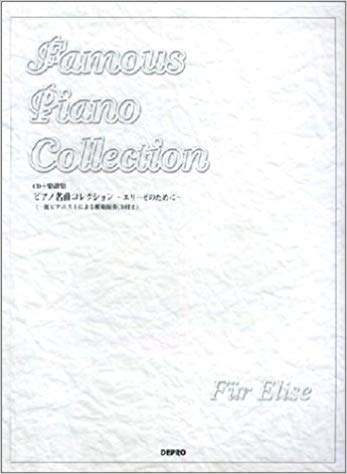Chopin, Frederic : Valse No.1 ''Grande valse brillante'' Es-Dur Op.18
Work Overview
Genre:waltz
Total Playing Time:5 min 00 sec
Copyright:Public Domain
Commentary (1)
Author : Yasukawa, Tomoko
Last Updated: December 1, 2009
[Open]
Author : Yasukawa, Tomoko
Score Collection Information
- Paderewski Edition: No. 1
- Ekier Edition: No. 1
- Cortot Edition: No. 1
- Henle Edition: No. 1
- Peters Edition (Urtext): No. 1 (also includes Appendix 1 [based on the autograph manuscript dated July 10, 1833], Appendix 2 [based on the revised autograph manuscript of Appendix 1 (1833)])
This waltz, widely known as "Grande Valse Brillante," was Chopin's first published waltz. Since the autograph manuscript does not include "Grand," it is presumed to have been added by the publisher. Its successive publication in Paris, Leipzig, and London in 1834, and its subsequent popularity, were related to the rising popularity of the waltz as a dance. Particularly in Paris, the status of the waltz rapidly improved, with its introduction into the Opéra balls in 1834, among other developments.
The dizzying turns and the resulting fervor and excitement are among the inherent charms of the waltz as a dance. Although Chopin did not fully resonate with the Viennese waltzes (Wiener Walzer) he heard during his stay in Vienna before moving to Paris in 1831, he appears to have been stimulated by them to some extent. The Waltz in E-flat major is one of the works where the influence of such Viennese waltzes is most strongly felt.
As symbolized by the four-bar introduction, the technique of repeating the same note and incorporating a duple meter feel into the triple meter rhythm through the effect of accents and slurs increases the speed of the turns without changing the tempo. Following this introduction, five sections (seven phrases) are linked in repetition, leading to a coda (finale) after a sudden pause that seems to halt the motion. While similar to the Viennese waltz form seen in Weber's Invitation to the Dance, the piece as a whole can also be interpreted as a three-part form: "E-flat major main theme section – middle section combining D-flat major and B-flat minor – E-flat major recapitulation, and coda," with Chopin's characteristic lyricism particularly evident in the middle section.
The fair copy autograph manuscript dated July 10, 1833, is dedicated to Laura Horsford, daughter of General George Horsford and also Chopin's piano student. As it differs in many respects from the final version (being in da capo form and lacking a coda), it is included in Appendix 1 of the new Peters edition. Meanwhile, in a letter dated July 18, 1834, to Feliks Wodziński, Chopin wrote, "I can send you the little Valse that has just been published," and in gratitude for an invitation to Geneva, he presented this waltz to Feliks's sister, Maria Wodzińska, for whom Chopin later developed deep affection. (For more on Maria Wodzińska, see Waltz, Op. 69-1.) Thereafter, it became customary for Chopin's waltzes to be presented to ladies and young women of the upper class. The waltz played a significant role in Chopin's steady establishment and success within Parisian salon culture.
PTNA & Partner Channel Videos(5items)
Sheet MusicView More
Scores List (84)

(株)ドレミ楽譜出版社

(株)全音楽譜出版社

(株)ヤマハミュージックエンタテインメントホールディングス

(株)全音楽譜出版社

(株)全音楽譜出版社

(株)全音楽譜出版社

(株)全音楽譜出版社

(株)全音楽譜出版社

(株)ドレミ楽譜出版社

(株)ドレミ楽譜出版社

KMP(ケイ・エム・ピー) ケイエムピー

(株)全音楽譜出版社

ミュージックランド

(株)リットーミュージック

(株)ドレミ楽譜出版社

(株)ドレミ楽譜出版社

KMP(ケイ・エム・ピー) ケイエムピー

ミュージックランド

(株)ドレミ楽譜出版社

ミュージックランド

(株)学研プラス

ミュージックランド

(株)オンキョウパブリッシュ〇

KMP(ケイ・エム・ピー) ケイエムピー

ミュージックランド

(株)ドレミ楽譜出版社

ミュージックランド

ミュージックランド

(株)全音楽譜出版社

(株)シンコーミュージックエンタテイメント

(株)全音楽譜出版社

(株)オンキョウパブリッシュ〇

ハンナ(ショパン)

(株)ヤマハミュージックエンタテインメントホールディングス

(株)ヤマハミュージックエンタテインメントホールディングス

(株)ヤマハミュージックエンタテインメントホールディングス

(株)ヤマハミュージックエンタテインメントホールディングス

(株)ドレミ楽譜出版社

(株)ヤマハミュージックエンタテインメントホールディングス

ハンナ(ショパン)

ミュージックランド

ミュージックランド

ミュージックランド

(株)シンコーミュージックエンタテイメント

(株)ドレミ楽譜出版社

(株)シンコーミュージックエンタテイメント

KMP(ケイ・エム・ピー) ケイエムピー

(株)シンコーミュージックエンタテイメント

ハンナ(ショパン)

(株)リットーミュージック

(株)ドレミ楽譜出版社

(株)共同音楽出版社

(株)ドレミ楽譜出版社

(株)ヤマハミュージックエンタテインメントホールディングス

ハンナ(ショパン)

ハンナ(ショパン)

ハンナ(ショパン)

(株)ヤマハミュージックエンタテインメントホールディングス

ハンナ(ショパン)

ミュージックランド

(株)ドレミ楽譜出版社

(株)ヤマハミュージックエンタテインメントホールディングス

ミュージックランド

(株)ヤマハミュージックメディア

ミュージックランド

ミュージックランド

(株)ドレミ楽譜出版社

(株)自由現代社

(株)ヤマハミュージックエンタテインメントホールディングス

ミュージックランド

KMP(ケイ・エム・ピー) ケイエムピー
![ショパン ワルツ集[遺作付] - 楽譜表紙画像](https://ptna-assets.s3.ap-northeast-1.amazonaws.com/enc/books/2392.jpg)
(株)全音楽譜出版社

(株)全音楽譜出版社
![[標準版ピアノ楽譜]ショパン ワルツ集 遺作付 - 楽譜表紙画像](https://ptna-assets.s3.ap-northeast-1.amazonaws.com/enc/books/2754.jpg)
(株)音楽之友社

(株)全音楽譜出版社

(株)ヤマハミュージックエンタテインメントホールディングス

ポーランド音楽出版社

ジェスク音楽文化振興会

(株)ヤマハミュージックエンタテインメントホールディングス












